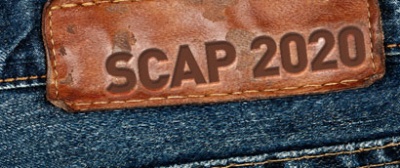WRAP report reveals SCAP signatories make progress on textile sustainability targets
A new report from the Waste and Resources Action Programme (WRAP) on the environmental impact of the UK clothing industry, released on Tuesday (11 July), has shown the potential of collaborative action in combatting this issue, as signatories to WRAP’s Sustainable Clothing Action Plan (SCAP) demonstrate progress in cutting water use, carbon and waste within the industry and throughout the entire life cycle of an item of clothing.
Largely thanks to the rise of fast fashion, textiles waste in the UK has been sharply increasing in recent years. Between 2010 and 2015, domestic clothing consumption increased from one million to 1.1 million tonnes, with England and Wales sending an estimated 620,000 tonnes to landfill, according to WRAP figures.
Wrap’s latest report, ‘Valuing our Clothes: the Cost of UK Fashion’, is an update of WRAP’s 2012 assessment of the industry that preceded the launch of the SCAP voluntary agreement the following year, which aims to drive forward more sustainable production and buying practices, increase the instances of re-use and recycling of clothing, and achieve real reductions in water use, carbon and waste by 2020.
SCAP is WRAP’s major initiative with signatories including major clothing designers, brands, manufacturers, retailers, fashion houses and re-use and recycling organisations.
Through a range of SCAP initiatives varying from sustainable fibre procurement, to advice and support for households on caring for clothes, to working to increase reuse and recycling, SCAP signatories have made impressive reductions in carbon and water use and waste on a per-tonne basis:
- Water use (2020 target of 15 per cent reduction): a 13.5 per cent reduction for every tonne of clothing sold by SCAP
- Carbon (2020 target of 15 per cent reduction): a 10.6 per cent reduction for every tonne of clothing sold by SCAP retailers
- Waste (2020 target of 3.5 per cent): a 0.8 per cent reduction for every tonne of clothing sold by SCAP retailers
Commenting on the report’s findings, Steve Creed, Director of Business Programmes at WRAP, said: “I am delighted by how well SCAP signatories are doing. At this stage of the agreement they are not only well on the way to achieving the targets, but continue to outperform the sector as a whole - particularly in sustainable cotton.
“It’s amazing that twenty percent more cotton is now sustainably-sourced by signatories than when we began. And having high-street names like M&S, Tesco and Sainsbury’s setting ambitious sustainable cotton targets will help ease the pressure on some of the world’s most water-sensitive countries.”
Now to focus on priority garments
Moving forward, WRAP is now calling on retailers and brands to focus on a number of priority garments which it has identified as having the highest environmental costs in terms of manufacture, and which sell in the largest numbers.
Top of the list are women’s dresses, jumpers and jeans, followed by men’s t-shirts and jumpers. Women’s jeans were singled out in terms of the amount of water used during their production, while dresses and jumpers and men’s t-shirts are similarly high volume products which require work to tackle their carbon footprint and supply chain waste.
WRAP is keen that attention remains firmly fixed on driving towards the SCAP 2020 targets, and the organisation is calling for more retailers to set goals of 70 per cent sustainable cotton by 2020, and help people take better care of their clothes at home and prolong their life.
The organisation wants an ambitious 60 per cent of household washes to routinely run at the lower 30°C setting on washing machines by 2020, with SCAP signatories and supporters helping householders make this switch.
WRAP also found that the amount of clothing in household residual waste has decreased since 2012, falling by 50,000 tonnes to 300,000 tonnes in the household waste stream. This is a fall of 14 per cent and represents the equivalent weight of more than 300 Jumbo Jets.
WRAP believes that a number of factors have driven this change, with reuse and recycling signatories helping to divert an increasing amount of clothing away from landfill at end of life, and lower clothing sales prior to 2012.
By examining every stage of a garment’s life from production to disposal, WRAP has identified key pressure points, as Steve Creed explained: “With rising global demand and pressure on resources, we urgently need to find new sources of materials – alternatives to the usual raw materials we rely on. And we urgently need to find new markets for used clothing. Fibre to fibre recycling is a key opportunity that the UK should explore commercially, and we will be focussing on this more through SCAP.
“While designing clothes to last longer is key to reducing the environmental impact at scale, making this happen requires a rethink by us all – shoppers and businesses. New business models that prolong the life of clothes, such as hiring and repair services, are an exciting new area for growth and there are real opportunities for UK Plc in these areas. We are only just beginning to see what’s possible through SCAP.”
Building on the Sustainable Clothing Action Plan
WRAP is not the only organisation tackling the problem of clothes waste, as the UK has seen a number of worthwhile initiatives start up in recent years, in addition to SCAP.
Environmental charity Hubbub hosted a series of ‘re-fashion’ events in London last year, and several Zero Waste Scotland initiatives have been designed to address the problem of unused clothing.
At an international level, WRAP is jointly responsible for the delivery of the European Clothing Action Plan (ECAP), along with four other organisations from the UK, The Netherlands and Denmark. This is a Europe-wide strategy to improve sustainability and embed a circular economy approach within the fashion industry through reducing the industry’s carbon, water and waste footprints and encouraging re-use of old clothes.
But despite the rise in action from several organisations, WRAP has made it clear that there is still significant work to do. Steve Reed added: “It’s great to see fewer clothes ending up in the residual waste, but overall our carbon footprint, including global and territorial emissions, has risen to more than 26 million tonnes CO2e.
“That’s nearly 2 million tonnes greater than five years ago due to increased clothing purchases, thanks to relatively low prices and the increased population.
“The next few years are critical in balancing this growing demand with supplying clothes more sustainably. I’m confident SCAP will play a big part in helping to make this happen, and make sustainable fashion much more mainstream.”
For more information on SCAP, visit the dedicated the SCAP page on the WRAP website, while you can also view the full version of WRAP’s ‘Valuing our clothes: the cost o UK fashion’ report.





